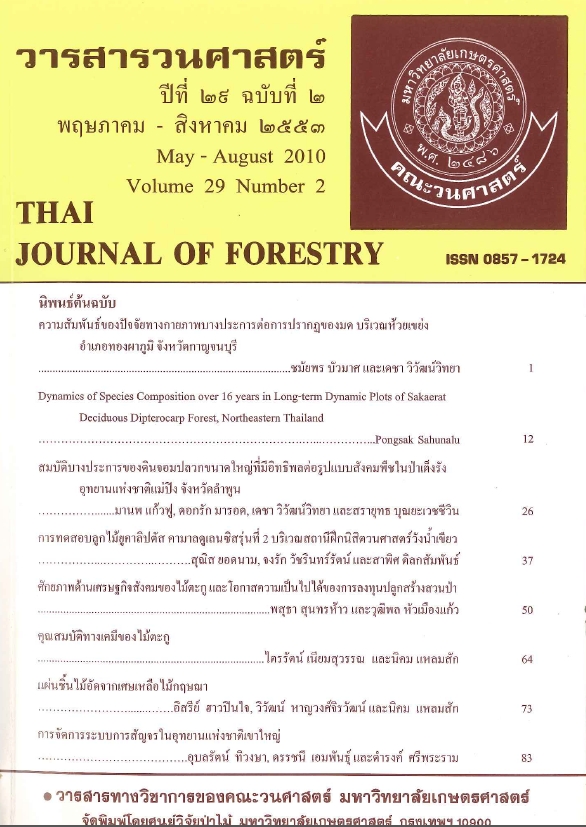สมบัติบางประการของดินจอมปลวกขนาดใหญ่ที่มีอิทธิพลต่อ รูปแบบสังคมพืชในป่าเต็งรัง อุทยานแห่งชาติแม่ปิง จังหวัดลำพูน
Main Article Content
บทคัดย่อ
การศึกษาสมบัติบางประการของดินจอมปลวกขนาดใหญ่ที่มีอิทธิพลต่อรูปแบบสังคมพืชในป่าเต็งรัง อุทยานแห่งชาติแม่ปิง อำเภอลี้ จังหวัดลำพูน ระหว่างเดือน กรกฎาคม 2551 ถึง มิถุนายน 2552 โดยการสำรวจชนิดพรรณพืชที่ขึ้นอยู่บนจอมปลวกจำนวน 15 จอม เปรียบเทียบกับสังคมพืชรอบจอมปลวกในป่าเต็งรังเพื่อวิเคราะห์ความสัมพันธ์ของดินจอมปลวกต่อการกระจายของพรรณพืช ผลการศึกษาพบว่า ปลวกชนิด Macrotermes annandalei มีความเด่นมากและเป็นปลวกที่มีการสร้างจอมปลวกขนาดใหญ่ในพื้นที่ จากกิจกรรมการสร้างจอม ทำให้สมบัติของดินจอมปลวกขนาดใหญ่มีความแตกต่างจากดินป่าเต็งรัง คือ ดินจอมปลวกมีปริมาณดินเหนียวมากกว่าดินในป่าเต็งรังอย่างมีนัยสำคัญทางสถิติ (ร้อยละ 32.98 และร้อยละ 16.05 ตามลำดับ p < 0.001) ค่าความหนาแน่นรวมของดินจอมปลวก รวมถึงค่าความเป็นกรด-ด่าง (pH) และปริมาณธาตุอาหารในดินที่มีมากกว่าดินในป่าเต็งรัง อย่างไรก็ตามปริมาณทรายในดินป่าเต็งรังมีปริมาณสูงกว่าดินจอมปลวกอย่างมีนัยสำคัญทางสถิติ (ร้อยละ53.66 และร้อยละ 39.53 ตามลำดับ p < 0.001) และจากการจัดลำดับสังคมพืชตามการลดหลั่นของปัจจัยแวดล้อม พบว่า ปริมาณดินเหนียว และค่า pH ของดินมีความสัมพันธ์ในทางบวกมากที่สุดต่อกลุ่มพืชที่ขึ้นอยู่บนจอมปลวกขนาดใหญ่ ต่างจากจากพรรณพืชในป่าเต็งรังที่กลุ่มพืชที่พบมีความสัมพันธ์กับปริมาณทรายและความพรุนของดินในทางบวก ส่วนความหลากหลายทางชีวภาพบนจอมปลวกขนาดใหญ่มีความหลากหลายทางชนิดพรรณพืชมากกว่าในป่าเต็งรัง พรรณไม้สำคัญในชั้นเรือนยอดบนจอมปลวกส่วนใหญ่เป็นพรรณไม้ในป่าเบญจพรรณและป่าดิบแล้ง เช่น ตะคร้อ (Schleichera oleosa) กัดลิ้น (Walsura trichostemon) ล่ำตาควาย (Diospyros coaetanea) มะแฟน (Protium serratum) ตะคร้ำ (Garuga pinnata) กระเจียน (Polyalthia cerasoides) ถ่านไฟผี (Diospyros montana) และกรวยป่า (Casearia grewiaefolia) เป็นต้น
ดังนั้นจากกิจกรรมของปลวกและสมบัติของดินจอมปลวกอาจส่งผลต่อโครงสร้างและองค์ประกอบพรรณพืช โดยจอมปลวกขนาดใหญ่มีส่วนสำคัญต่อการเพิ่มความหลากหลายชนิดพรรณพืช และปริมาณธาตุอาหารให้แก่ป่าเต็งรัง
คำสำคัญ: จอมปลวกขนาดใหญ่ ดินจอมปลวก รูปแบบสังคมพืช ป่าเต็งรัง อุทยานแห่งชาติแม่ปิง
Downloads
Article Details

อนุญาตภายใต้เงื่อนไข Creative Commons Attribution-NonCommercial-NoDerivatives 4.0 International License.
ข้าพเจ้าและผู้เขียนร่วม (ถ้ามี) ขอรับรองว่า ต้นฉบับที่เสนอมานี้ยังไม่เคยได้รับการตีพิมพ์และไม่ได้อยู่ในระหว่างกระบวนการพิจารณาตีพิมพ์ลงในวารสารหรือสิ่งตีพิมพ์อื่นใด ข้าพเจ้าและผู้เขียนร่วม (ถ้ามี) ยอมรับหลักเกณฑ์และเงื่อนไขการพิจารณาต้นฉบับ ทั้งยินยอมให้กองบรรณาธิการมีสิทธิ์พิจารณาและตรวจแก้ต้นฉบับได้ตามที่เห็นสมควร พร้อมนี้ขอมอบลิขสิทธิ์ผลงานที่ได้รับการตีพิมพ์ให้แก่วารสารวนศาสตร์ คณะวนศาสตร์ มหาวิทยาลัยเกษตรศาสตร์ กรณีมีการฟ้องร้องเรื่องการละเมิดลิขสิทธิ์เกี่ยวกับภาพ กราฟ ข้อความส่วนใดส่วนหนึ่ง หรือ ข้อคิดเห็นที่ปรากฏในผลงาน ให้เป็นความรับผิดชอบของข้าพเจ้าและผู้เขียนร่วม (ถ้ามี) แต่เพียงฝ่ายเดียว และหากข้าพเจ้าและผู้เขียนร่วม (ถ้ามี) ประสงค์ถอนบทความในระหว่างกระบวนการพิจารณาของทางวารสาร ข้าพเจ้าและผู้เขียนร่วม (ถ้ามี) ยินดีรับผิดชอบค่าใช้จ่ายทั้งหมดที่เกิดขึ้นในกระบวนการพิจารณาบทความนั้น”


